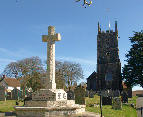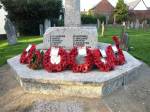George Reed was a distinguished soldier, a veteran of the Boer War, and whose name is proudly recorded in the Chumleigh Deanery Magazine as having re-enlisted as a reservist in the first months of 1914. Obviously a very fit man, he was (according to the 1911 census) already 40 years old when war began, but in order to serve, George stated that he was only 38. We are extremely fortunate that not only his medal card but an almost entire set of documents relating to his full army career and war service have survived the bombing which destroyed so many priceless archives, and from these the full picture emerges.
In 1911 George, aged 37, was living in a cottage on the Exeter Road with his wife Annie and their children William George aged 5, Kathleen May, 3, and a baby Mildred Gladys aged 2 months. At enlistment the medical history sheet records that he had married Annie Cayzor on 15th October 1905, and was then living in Penzance, where the two eldest children had been born. Arriving in Winkleigh some time before 1910, the new baby had been born in the village. The 1911 census describes George as a Marine Store dealer, with his wife assisting him, no doubt still carrying on at long distance a business that he was running in Penzance. An Albert Reed, two years younger than George and who was farming at Collacott Farm, with a wife and two children, is also recorded in the 1911 census, (but also not in 1901), but we have as yet no link between the two men who might, one supposes, have been related.
George Reed was enlisted by Col. Alexander, a local JP, acting as the recruiting officer for Winkleigh, on 9th October 1914. Here it is recorded that George had already served 9 years with the colours and 3 years in the reserve, in the Royal Field Artillery. He had been a horse driver, one of a team of three drivers per field gun controlling 6 horses, and now George, describing himself again as a horse driver, made sure that this time he could choose the same occupation in the somewhat safer option of the Army Service Corps. The medical inspection was held at Exeter on 12th October, and George is described as a fit man, ready for service as a transport driver in the ASC. The military sheet reveals that his service in the Boer War was indeed distinguished, with action at the battles of Talana, the defence of Ladysmith and Langs Nek, earning George both the Queen’s Medal and the King’s Medal, with clasps for all three, and having served in the Orange Free State and the Transvaal. He had been wounded slightly at Ladysmith, but with no ill effects. On re-joining the army he first served at home between 9th October 1914 and 14th January 1915, attached to the 28th Division, before moving to France on 17th January (confirmed by his medal card).
The 28th Division was one of three Divisions (27th – 29th) formed mainly of regular army troops brought home from various parts of the Empire, supplemented with territorial units. The 28th formed up at three camps near Winchester between December 1914 and January 1915, and was immediately sent as the first major reinforcement to France. The units of the Division embarked at Southampton and landed at Le Havre on 16-19 January 1915 and then moved to concentrate in the area between Bailleul and Hazebrouck. George’s records show that he was attached to the Divisional supply train to 365 Battery of the Royal Field ArtilleryThe Division subsequently took part in the Second Battle of Ypres (22nd April – 25th May, where the Germans first used poison gas) and the Battle of Loos (25th September – 18th October). George had been posted to the 3rd Battery RFA on 7th August 1915. On 3rd December a surprise was then in store: the Division was ordered on 19 October 1915 to prepare to sail to Egypt. The first units left Marseilles for Alexandria five days later and all units (except 2 Brigades of the RFA) were there by 22 November. The Division was then ordered on to Salonika and completed its disembarkation on 4 January 1916. George, however did not go with them to Egypt, instead destined to remain in France. On 23rd November George was posted to the 33rd Divisional Train of the 33rd Division, which was on its way out from England, concentrating at Morbecque. From the Divisional Train HQ George was posted on 18th December to 1277 Coy. RASC, and from there to 167 Howitzer Brigade of the Royal Field Artillery. He was then granted 7 days’ leave from 24th to 31st January 1916 to see his family in Winkleigh.
George was then fully involved in the 33rd Division’s activities until the end of the war. Preparations for the July 1st opening of the Battle of the Somme must have taken a heavy toll of the supply columns for the heavy howitzers, but at least George would have been well behind the front lines on the opening day and in subsequent weeks. On 31st July George was admitted into hospital for four weeks suffering from influenza, rejoining 167 Brigade on 31st August. The 167th Brigade was broken up on 12th September, and George returned to the 33rd Divisional supply train. He was certainly serving in the headquarters No. 1 Company when he was granted 10 days leave from 15th to 25th August 1917. George remained with the Divisional headquarters transport, as recorded by his next leave, 14 days from 4th to 18th March 1918. On 17th June 1918 George was still serving with 1st HQ Company of the 33rd Divisional train when he was awarded the 3rd Class badge of the ASC, presumably for his long service. On 23rd November 1918 he was granted 4 years war pay (as an enlisted reservist) The war now over, he was given 14 days leave from 25th March 1919 to 8th February, and finally returned on 18th June to the UK for demobilisation, just before the final dissolution of the Division on 30th June.
George had witnessed many of the battles in which the 33rd Division had been involved, almost entirely a New Army Division. The 1916 Somme campaign saw the 33rd involved on the opening day, the July 14th Battle of Bazentin followed by the agony of High Wood. In 1917 the 33rd was involved in the two battles of the Scarpe (phases of the Arras offensive), and then the Passchendaele offensive where the Division was involved in the battles along the Menin Road and for Polygon Wood. Among the many actions in 1918 were the battle of Messines, the actions to break the Hindenburg line, and the final advance in Picardy. On November 11th the Division HQ was in the valley of the Sambre, near Laval. On 4th December the King inspected the Division at Hornoy. With demobilisation continuing, the Division moved to Le Havre on 28th February and by 30th June had ceased to exist. George had served with the Divisional headquarters until the very end, one of the very last to go home.
As with all demobilised soldiers, George received his Protection Certificate on 20th June at the No.1 Dispersal Unit at Fovant, and was re-classed as a ‘Z’ Reservist. He is recorded at the end serving in 170 Coy.ASC, now having re-trained to work with the Heavy Motor-Transport, a mark of how the now re-named Royal Army Service Corps had moved on a long way from almost total reliance on horses.
During the war, Annie Reed had opened a china shop on the Exeter Road, now George’s recorded address. He was 46 years old, his three children still of school age, a man who had survived two wars, and who could proudly wear, in addition to his Boer War medals, the 1915 Star to add to his Victory and British medal decorations.
16 July 2011


